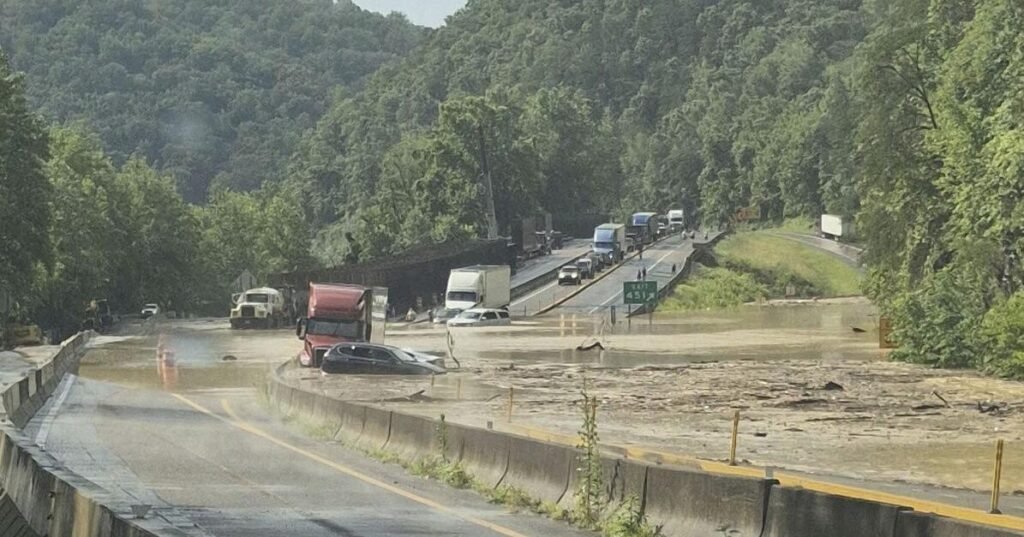I-40 Reopens in the Smokies: Nature’s Reminder of the Mountain’s Power
If you’ve ever driven through the majestic corridor where Interstate 40 cuts through the Great Smoky Mountains, you know it’s one of the most breathtaking stretches of highway in America. But sometimes, the mountains remind us who’s really in charge.
After a tense period of closure due to flooding and a significant rock slide, crews have successfully reopened a section of Interstate 40 that winds through the Great Smoky Mountains near Hartford, Tennessee. The reopening on Friday comes as welcome news to both locals and travelers who rely on this crucial east-west artery.
What Happened in the Smokies?
I’ve been writing about these mountains for years, and they never cease to amaze me – sometimes in challenging ways. Recent heavy rainfall triggered both flooding and a substantial rock slide along the narrow I-40 corridor that threads through the eastern edge of the Great Smoky Mountains National Park.
This particular stretch of interstate is famous for its dramatic views and equally dramatic geological features. The highway hugs steep mountain slopes, with the Pigeon River running alongside – a beautiful but sometimes dangerous combination when heavy rains come.
The Impact on Local Communities and Travelers
Closures along I-40 in this region aren’t just inconvenient – they’re economically impactful. This vital interstate connects North Carolina and Tennessee, serving as a major commercial and tourist route. When it closes, travelers face lengthy detours through winding mountain roads that can add hours to journey times.
For locals who’ve lived in the shadow of these mountains for generations, these events are a reminder of the respect the Smokies demand. As one longtime resident once told me, “The mountains give, and sometimes they take away – but they always have the final say.”
The Engineering Challenge of Mountain Highways
What makes this stretch of I-40 particularly vulnerable is the same thing that makes it so spectacular – its location. Carved into mountain slopes with the Pigeon River below, the highway exists in a narrow space where nature’s forces converge.
The Tennessee Department of Transportation crews deserve tremendous credit for their rapid response. Clearing rockslides isn’t just about moving debris – it’s about ensuring the mountain slope is stable enough to prevent further slides that could endanger travelers.
The Smokies’ Weather Patterns
Having covered the Smokies for years, I’ve seen how their unique geography creates weather patterns that can change dramatically. The mountains can receive significantly more rainfall than surrounding areas, with some spots in the park recording over 85 inches annually. This rainfall feeds the lush forests that give the Smokies their signature blue haze, but it also creates conditions ripe for flooding and slides.
Traveling Through the Smokies Safely
If you’re planning travel through this beautiful but sometimes unpredictable region, here are a few tips I’ve learned over the years:
- Always check road conditions before departing, especially after heavy rains
- Have alternative routes planned, particularly during rainy seasons
- Keep emergency supplies in your vehicle, including water and snacks
- Maintain a full tank of gas when traveling through mountain corridors
The Silver Lining
While these closures create challenges, they also remind us of something important: these mountains are living, breathing entities. The same geological processes that cause rock slides are what created the stunning landscape that draws millions of visitors annually.
The reopening of I-40 is good news for everyone who travels through or lives near this remarkable landscape. As we return to our normal routines, perhaps we carry with us a renewed appreciation for both the power and beauty of the Great Smoky Mountains.
Looking Forward
As someone who’s spent countless hours exploring these mountains, I can tell you that each challenge they present ultimately deepens our connection to them. The Smokies have stood for millions of years and will continue to shape the landscape – and occasionally our travel plans – for millions more.
The next time you drive that spectacular stretch of I-40 through the mountains, take a moment to appreciate not just the view, but the impressive engineering and maintenance work that makes your journey possible.
For the latest updates on road conditions in the Great Smoky Mountains region, visit the Tennessee Department of Transportation website or call their hotline before planning your trip.

